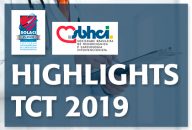Patients with cardiovascular disease infected with COVID-19 are at a particular risk for morbidity and mortality. In any case, it should be noted that most patients requiring cardiovascular care due to ischemic heart disease, peripheral vascular disease, or structural heart disease are not infected. Being prepared to face this pandemic is as important as guaranteeing…
How is the Pandemic Affecting MI? The Chinese Experience
ST elevation acute myocardial infarction has high mortality and morbidity rates. It is normally treated with primary PCI. The whole system has established very effective protocols to minimize ischemic time from symptom onset to definite treatment in the cath lab. This study reports the experience in Hong Kong since January 2020, when all emergency protocols…
Reperfusion in the Time of COVID-19. What Has Changed?
We are living a pandemic due to the new COVID-19, but the world was already in the midst of a pandemic of cardiovascular disease. Both challenges defy healthcare systems worldwide, and the worst part is that they can coexist. Some symptoms for both diseases can overlap (such as respiratory distress) and they are unreliable, like…
16 Years of Superiority of Primary Angioplasty
The DANish Acute Myocardial Infarction 2 (DANAMI-2) trial showed the 30-day superiority of patient transport to a primary angioplasty site vs. fibrinolysis at the hospital where the patient had been originally admitted. Those 30-day results became a landmark in the history of interventional cardiology. However, some suspected that such initial benefit could fade away over…
5 Years of FAST-MI: If Unable to Meet the Timeline, Thrombolization Is the Way to Go
A large proportion of patients undergo primary angioplasty beyond the timelines recommended by clinical practice guidelines. These patients have poorer 5-year outcomes compared with those subjected to a pharmaco-invasive strategy. ST-segment elevation myocardial infarction guidelines recommend primary angioplasty as the strategy of choice within 120 min after a diagnostic electrocardiography. If that is not possible, thrombolytic…
Off-hours Primary PCI Still Have the Highest Mortality Rate?
According to this contemporary study, in the current organized STEMI network, patients admitted to a tertiary high-volume center for primary PCI are managed similarly and have similar prognosis regardless admission time. Several prior studies have shown primary PCI during off-hours (6 pm to 8 am) had worse outcomes vs. on-hour interventions (8 am to 6…
AHA 2019 | COMPLETE: Complete Revascularization Is Superior since It Treats Other Vulnerable Plaque
This COMPLETE sub-study using optical coherence tomography (OCT) showed the prevalence of vulnerable lesions other than the culprit which should provide a physiopathological explanation of the benefit of complete revascularization observed in the original study. STEMI patients with multivessel disease will benefit from complete revascularization in terms of reduced cardiovascular death and repeat MI according…
TCT 2019 | COMPLETE: Sub-Study to Find Out Complete Optimal Revascularization Timing in STEMI
Courtesy of SBHCI. The COMPLETE study was carried out to assess the benefit of complete revascularization vs culprit vessel revascularization in the context of ST elevation acute myocardial infarction. This COMPLETE sub-study presented at TCT 2019 scientific sessions simultaneously published in JACC assessed the optimal timing of complete revascularization. The general study had already shown…
Revascularization in Spontaneous Coronary Artery Dissection Causing ST-Segment Elevation Myocardial Infarction
Spontaneous coronary artery dissection is an increasing cause of acute myocardial infarction, particularly in younger women. These infarctions are frequently treated conservatively given the risks entailed by revascularization, due to the possibility of causing an antegrade or retrograde expansion of the dissection. The uncertainty around treatment for these patients gave way to this study (recently…
Drug Coated Balloons vs. Drug Eluting Stents in Primary PCI
There might come the time when we are finally able to leave nothing behind, at least in the context of primary PCI. The REVELATION study, soon to be published in J Am Coll Cardiol Intv, has shown that paclitaxel coated balloons resulted non inferior to drug eluting stents (DES) in terms of FFR (fractional flow…








